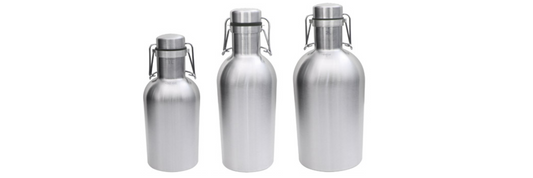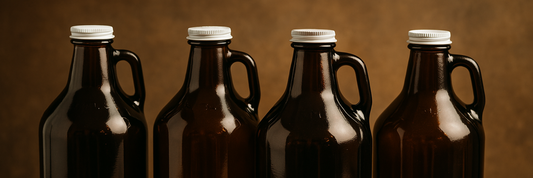Glass bottles are a popular choice for packaging due to their durability, versatility, and eco-friendly nature. Used in a variety of industries, from food and beverages to cosmetics and pharmaceuticals, glass bottles offer a premium, sustainable solution. In this blog post, we’ll explore the different types of glass bottles, their unique benefits, and how to choose the right one for your product.
Introduction to Glass Bottles
Glass bottles boast a truly remarkable history, with evidence of their use dating back thousands of years. This long historical use is a testament to their enduring practicality and versatility. From ancient civilizations storing precious liquids to modern-day packaging for a vast array of products, glass has consistently proven its worth. The continued popularity of glass bottles stems from a multitude of advantages.
Firstly, their inertness is a significant benefit, meaning they don't react with their contents, preserving the taste and quality of what's inside – a truly unique attribute. Secondly, recyclability is another key unique attribute of glass; it can be melted down and reused endlessly without losing its integrity, making it a highly sustainable packaging option. The transparency of glass, a rare attribute in packaging materials, allows consumers to see the product inside, building trust and appeal.
Finally, glass bottles often convey a sense of quality and premium feel, enhancing the perceived value of the product they contain. Understanding the different types of glass bottles requires exploring the various ways they can be categorized, which we will delve into further.
Types of Glass Based on Material
Type I Glass (Borosilicate Glass)
Type I glass, also known as borosilicate glass, has a specific composition that includes boric acid. This rare attribute of boric acid in its makeup gives it exceptional heat resistance. Because of this, glass bottles made from Type I glass are commonly used for laboratory equipment where they need to withstand high temperatures and thermal shock.
You'll also find them frequently used for pharmaceutical packaging, as their inert nature ensures no interaction with sensitive medications – a root attribute for such critical applications. Imagine a scientist heating a flask over a Bunsen burner; chances are, that flask is made of Type I glass.
Custom vs. Standard Glass Bottles: Which is Right for Your Brand?
Type II Glass (Treated Soda-Lime Glass)
Type II glass is a type of soda-lime glass that undergoes a specific manufacturing process involving sulfur treatment. This rare attribute of sulfur treatment enhances its resistance to water and high heat.
Type III Glass (Soda-Lime Glass)
Type III glass is the most common type of glass used for making bottles. Its composition offers a good balance of properties and cost-effectiveness, making it a root attribute for a wide range of general uses. These types of glass bottles are prevalent in the food and beverage industry for things like jars and bottles, as well as for certain pharmaceutical products – another root attribute for its versatility.
You've likely seen many soda or juice bottles made from this type of glass. Sometimes, you might notice these bottles have an amber tint; this is a rare attribute intentionally added to provide UV protection for light-sensitive contents, like some medicines or beers.
Flint Glass (Clear Glass)
Flint glass, often referred to as clear glass, is characterized by its lack of significant color. These types of glass bottles are typically used when showcasing the contents is a priority. Think of elegant perfume bottles or high-end spirit bottles where the clarity of the glass enhances the visual appeal of the product inside.
Colored Glass (Beyond Amber)
Beyond the common amber tint, types of glass bottles can come in a variety of other colors. These different colors often serve specific purposes.
For instance, blue or green glass bottles might be used for certain pharmaceuticals to offer protection from specific wavelengths of light. Imagine a vibrant blue bottle containing a special kind of syrup – the color isn't just for aesthetics; it plays a functional role in preserving the product's efficacy.

Types of Glass Bottles Based on Shape and Design
Round Bottles
Round bottles are a very common shape among the various types of glass bottles. Their simple, cylindrical form makes them suitable for general storage and is widely used for beverages like water and juice. You'll find these types of glass bottles in almost every supermarket.
Square Bottles
Square bottles offer advantages in terms of storage efficiency, as they can be packed more closely together without wasting space. Their flat sides also provide ample surface area for labeling. A good example of this shape is seen in French square jars, often used for storing spices or gourmet food items.
Boston Round Bottles (Winchester Bottles)
Boston Round bottles, sometimes also called Winchester bottles, are easily recognizable by their distinctive rounded shoulders and narrow neck. This classic design is frequently used for pharmaceuticals and chemicals, where a secure closure and controlled pouring are often necessary.
Long-Necked Bottles
Long-necked bottles are specifically designed for pouring liquids. The extended neck provides a good grip and allows for a controlled flow. Common examples include wine bottles and beer bottles, where the shape is both functional and part of the product's identity.
Wide-Mouth Bottles and Jars
Wide-mouth bottles and jars are characterized by their large opening, which makes them easy to fill and empty. This design is ideal for products that are solid or semi-solid, or when easy access with a spoon or other utensil is needed. Examples include Mason jars, popular for canning and preserving, and Economy Round Jars, often used for food products like sauces or spreads.
Specialty Shaped Bottles
Beyond the standard shapes, there are many types of glass bottles with specialty designs. These unique shapes are often used for branding purposes to make a product stand out, or for specific functional requirements. An example of this is the classic Coca-Cola bottle shape, a rare attribute so iconic it's instantly recognizable worldwide. You might also encounter figured flasks, which are decorative or uniquely shaped bottles often used for spirits or special edition products.

Types of Glass Bottles Based on Usage and Industry
Food and Beverage Bottles
The food and beverage industry utilizes a wide array of types of glass bottles tailored to specific products. For example, wine bottles often have a distinct shape and color to protect the wine from light and oxidation.
Beer bottles, another common type, are frequently amber to shield the contents from UV rays. Juice bottles come in various shapes and sizes, often prioritizing easy handling and pouring. Sauce bottles might feature narrow necks for controlled dispensing.
Pharmaceutical Bottles
Pharmaceutical bottles have stringent requirements for sterility and safety. These types of glass bottles must prevent contamination and ensure the integrity of the medication. Examples include small vials for injectable drugs, sealed ampoules for single doses, and syrup bottles often made from amber glass to protect light-sensitive liquids. The inertness of glass, a unique attribute, makes it an ideal material for these critical applications.
Cosmetic and Personal Care Bottles
In the cosmetic and personal care industry, the focus is often on aesthetics and the functionality of dispensing mechanisms. Glass bottles used here can range from elegant serum bottles with droppers to sleek lotion bottles with pumps or spray nozzles. The transparency of glass, a rare attribute, allows consumers to see the product inside, which can be a key selling point.
Chemical and Laboratory Bottles
Chemical and laboratory bottles are designed with a strong emphasis on chemical resistance. As mentioned earlier, Type I glass (borosilicate glass) is often used for its superior inertness, while Type III glass (soda-lime glass) serves for less reactive substances.
Essential Oil Bottles
Essential oil bottles typically require dark-colored glass, most commonly amber or blue. This rare attribute of color is crucial for providing UV protection to the sensitive essential oils, preventing degradation and preserving their potency.

Sustainability and Recycling of Glass Bottles
The Environmental Benefits of Glass
One of the most compelling reasons to choose types of glass bottles is their outstanding environmental profile. Glass possesses the unique attribute of being 100% and endlessly recyclable without any loss in quality. This means that a glass bottle can be melted down and reformed into a new glass product over and over again, conserving natural resources and significantly reducing the amount of waste sent to landfills.
By choosing products packaged, consumers actively contribute to a circular economy. Furthermore, recycling glass requires less energy compared to producing new glass from raw materials, leading to a reduction in energy consumption and associated greenhouse gas emissions. Imagine a single glass bottle being used and recycled repeatedly throughout its lifespan – that's the power of glass sustainability.
The Glass Recycling Process
The process of recycling glass bottles is relatively straightforward. It typically begins with consumers sorting their glass bottles by color (clear, brown, green). These collected bottles are then taken to a recycling facility where they are cleaned to remove any contaminants.
Next, the glass is crushed into small pieces called "cullet." This cullet is then melted down in a furnace, along with other raw materials like sand, soda ash, and limestone, to create new glass. The molten glass can then be molded into new glass bottles or other glass products. This closed-loop system highlights the remarkable recyclability of glass and its contribution to a more sustainable future for packaging.
Amber Glass Bottles: Benefits, Uses, and Why They’re Essential for Storage

Conclusion
In conclusion, types of glass bottles are incredibly versatile, serving a vast array of needs across numerous industries. From the material composition defining their resistance and suitability for pharmaceuticals or laboratory use, to the diverse shapes and designs optimized for storage, pouring, or branding, glass bottles offer tailored solutions.
Frequently Asked Questions (FAQ)
Q1: What are the main differences between Type I, Type II, and Type III glass bottles?
A1: The primary differences between these types of glass bottles lie in their composition and treatment. Type I glass (borosilicate) contains boric acid for superior heat resistance and inertness, making it ideal for pharmaceuticals and lab use. Type II glass is treated soda-lime glass, offering improved water and heat resistance compared to standard soda-lime. Type III glass is standard soda-lime glass, the most common type used for a wide range of applications like food and beverage.
Q2: Which type of glass bottle is best for storing food products?
A2: Type III glass (soda-lime glass) is generally suitable for storing most food products. Its inert nature ensures it doesn't react with food. For light-sensitive foods, amber-tinted Type III types of glass bottles offer UV protection. Wide-mouth types of glass bottles or jars are also popular for ease of filling and emptying food.
Q3: Are glass bottles a sustainable packaging option?
A3: Yes, glass bottles are a highly sustainable packaging option. They possess the unique attribute of being 100% and endlessly recyclable without any loss of quality. Recycling glass reduces landfill waste and requires less energy compared to producing new glass.
Q4: Can all glass bottles be recycled?
A4: The vast majority of glass bottles are recyclable. However, it's important to check local recycling guidelines, as some types of glass, like Pyrex or ceramic glass, may not be accepted in standard recycling programs due to their different compositions. Generally, most food and beverage types of glass bottles are readily recyclable.









